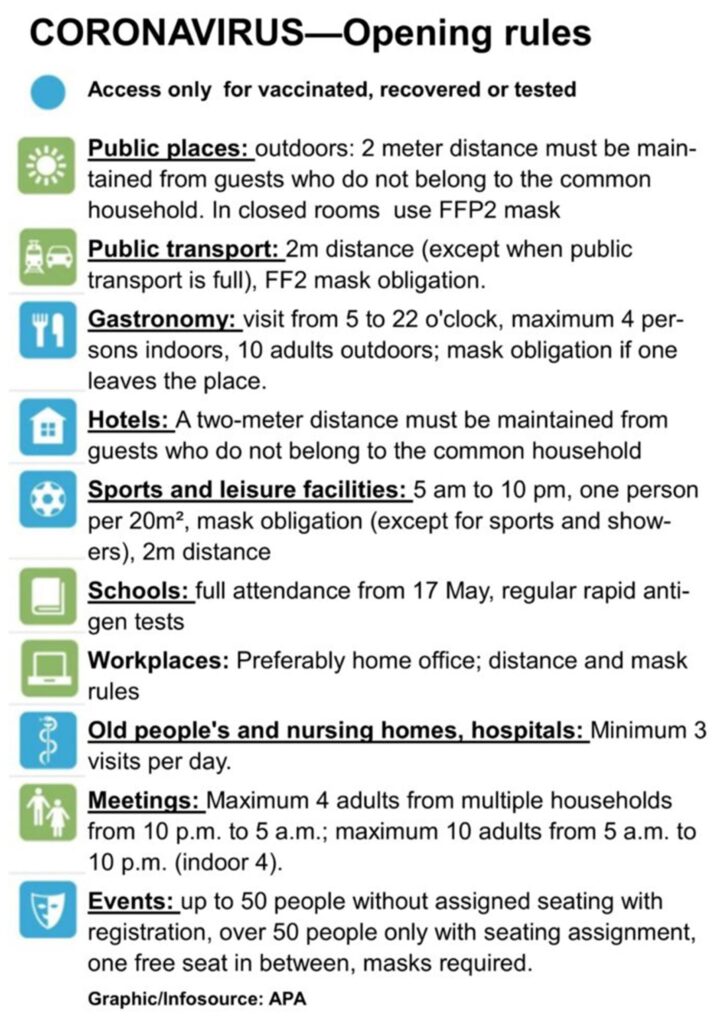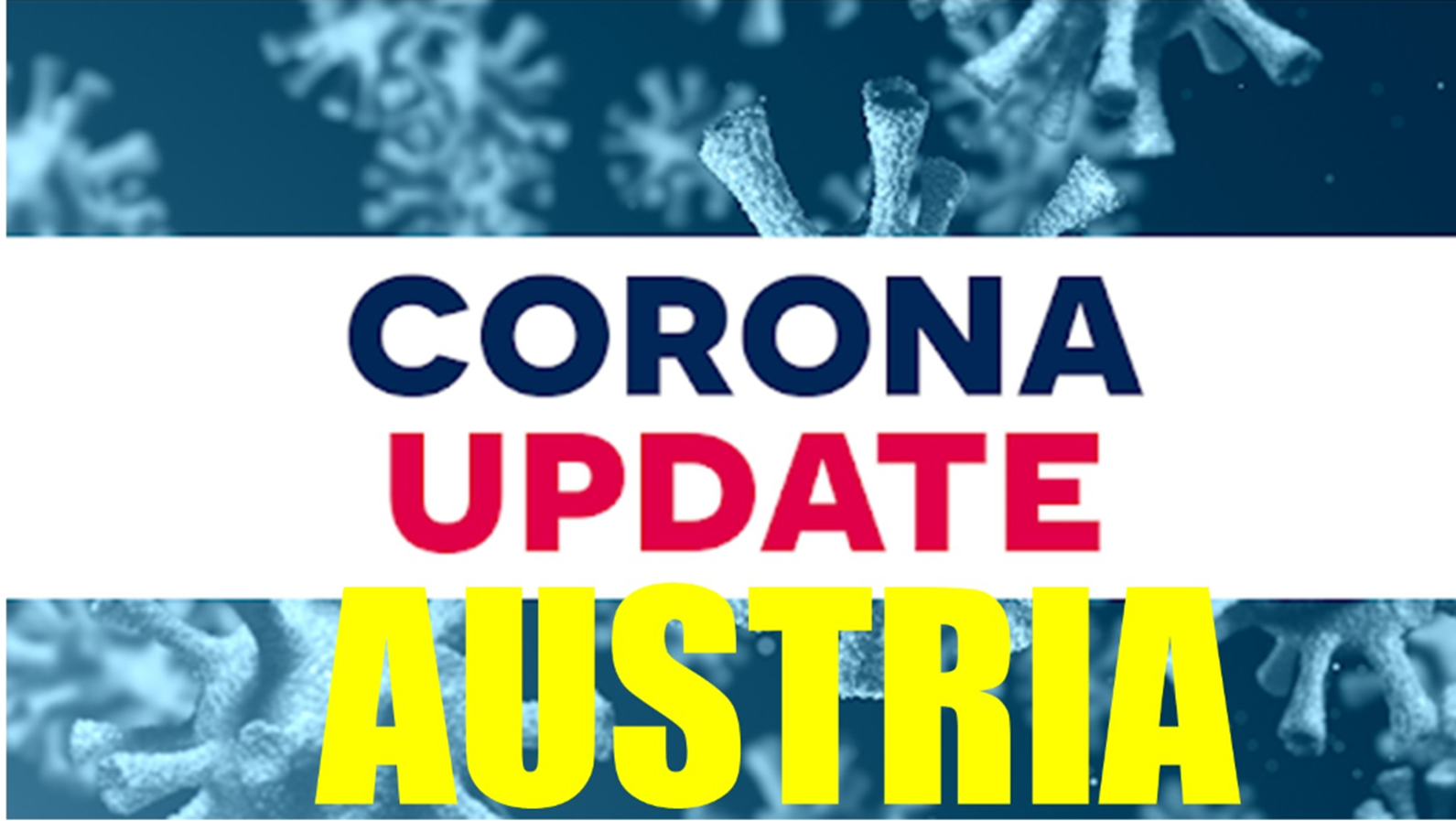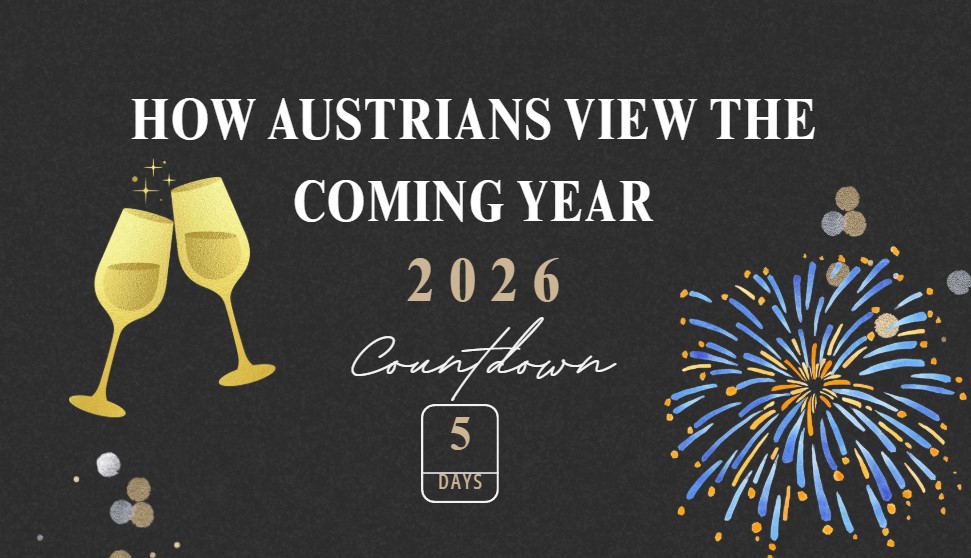The federal government has reached an agreement with the states to widely open Corona restrictions starting May 19. Tourism, hospitality, sports and recreation businesses can open with restrictions.
Tested, vaccinated or recovered: Those who want to take advantage of the openings announced for May 19 must meet one of these three criteria.
After consultations with the provinces, the federal government on Monday announced the Corona opening rules that will apply from May 19. Below are the details:
🔬💉🙂 The “three Gs”: (getestet, geimpft, genesen) tested, vaccinated or recovered.
The basic rule of the openings is that they are taken under special safety precautions. The main point of the safety concept is the definition of persons who pose a “low epidemiological risk.” Here, the “three Gs” are referred to as “vaccinated, tested, recovered.” The “evidence of low epidemiological risk” can be provided in three different ways:
▶️ Different tests:
Antigen self-tests for self-administration and recording in a regulatory data collection system are valid for 24 hours. Such testing may also be done under the supervision of the operator of a facility.
If the antigen tests are performed by an authorized body, the validity period is 48 hours.
A PCR test may be taken 72 hours in the past.
Point-of-sale tests for one-time entry into sports facilities, business premises, restaurants, hotels or an event complete the offer.
▶️ Recovery: Those who have recovered are exempt from testing for six months after the end of the infection. Evidence includes, for example, a certificate of segregation or a physician’s confirmation of an infection confirmed by molecular biology. Evidence of neutralizing antibodies counts for three months from the date of testing.
▶️ Vaccination: Vaccination with a vaccine approved by the European Medicines Agency EMA also counts as proof.
The initial vaccination is valid from the 22nd day after the first sting for a maximum of three months from the date of vaccination.
The second sting extends the validity period by another six months.
Vaccines where only one vaccination is scheduled (e.g., from Johnson & Johnson) are valid for a total of nine months from the date of vaccination beginning on the 22nd day after vaccination.
For recovered individuals who have previously been vaccinated once, the vaccine is valid for nine months from the date of vaccination.
From May 19, all previous proof of this will be valid, and from the beginning of June it will also be valid as a certificate/QR code in the digital “Green Passport”. Vaccinations can be documented with the vaccination card.

⚠️ General rules and exit restriction.
Under the opening regulation, there will no longer be any exit restrictions. So, the house may be left again around the clock without any reason. Nevertheless, the following rules apply:
The minimum distance of two meters remains almost everywhere (exception: at the table in the inn, events with assigned seating).
Covid 19 prevention concepts must be drawn up and Covid 19 officers appointed in all newly opened areas.
After 10 p.m., a general curfew applies to all businesses, events and sports venues.
During the day, gatherings of four people indoors (plus six minor children) are permitted, and ten people outdoors (plus ten minor children).
From 10 p.m. to 5 a.m., only gatherings of four people plus a maximum of six minor children are permitted.
The previous rule for FFP2 masks remains unchanged.
Registration requirement for guests at restaurants, hotel, events and leisure operations indoors as well as outdoors (exception for low interaction: e.g. zoo, outdoor pools, etc.).
🍝 Gastronomy
Food service visits will generally be allowed from 5 a.m. to 10 p.m. The three-G rule applies: entry only for tested, recovered or vaccinated persons. Registration is also required for stays of 15 minutes or more.
Indoor: In indoor areas, visitor groups may consist of a maximum of four adults (plus a maximum of six underage children) – or people from the same household.
Outdoor: Outdoors, groups of no more than ten people (plus a maximum of ten minors) are permitted. A distance of two meters must be ensured between the groups, and masks are compulsory indoors away from the seating area.
Food and beverages may only be consumed at the seating area, and in the case of snack and catering stands at serving areas, also while standing. Pick-up of food is possible during regular opening hours (5 a.m. to 10 p.m.). No test is required for snack stands and for pickup.
Excluded from the restrictions – such as curfew – are catering establishments in hospitals, old people’s homes and nursing homes, schools and kindergartens, company canteens and means of mass transportation (such as railroad dining cars).
🛌 Hotel and lodging industry:
Lodging tourism is allowed to reopen. Here, too, the three-G rule (vaccinated, tested or recovered) applies. In lodging only, a single entry test is sufficient for the entire stay.
A two-meter distance must be maintained from guests who do not belong to the common household or are not accommodated in a common accommodation unit. Masks are also mandatory in generally accessible indoor areas.
🛒 Commerce and Services:
Stores: no three-G proof required, 20 square feet of space must be provided per customer.
Three-G proof required for body-related services, only ten square feet required per customer.
🥁 Meetings and events
Events are now regulated under the term “gatherings”:
Under ten persons, gatherings are permitted without notification or authorization.
Gatherings of eleven or more people (up to 50 people, without assigned and designated seating) are permitted in compliance with the three-G rule if there is a registration of the participants (name and telephone number/e-mail) and there is a person in charge. The latter must notify the competent district administrative authority of the gathering at least one week in advance. In addition, an FFP2 mask must be worn both indoors and outdoors and the two-meter distance rule to non-household persons must be observed. The serving of beverages and the serving of food are not permitted. This rule applies to weddings, garden parties and similar events.
Only events with assigned seating are permitted for 51 or more persons. These must be approved by the local health authority.
Up to 1500 attendees are permitted indoors, and up to 3000 outdoors, in each case with a mask requirement. Also, there may be a maximum of 50 percent occupancy of the venue and participants must also show proof (test, vaccination, recovered).
Garages, gardens, sheds or barns: private residential areas are exempt from these regulations, but not areas that do not serve immediate residential needs (garages, gardens, etc.). Funerals or, for example, professional gatherings for professional training and education purposes are also exempt.
The same regulations apply to museums as to retail: no three-G proof and 20-square-foot rule.
🎪 Recreational businesses:
The three-G rule applies here as well.
Indoor (e.g., in pools and spas), an area of 20 square meters must be available per guest in the respective enclosed space.
Every leisure operation must draw up a prevention concept and appoint a COVID 19 officer.
For rides (e.g. carousel), there must be an empty seat between visitors.
Registration of customers is required indoors.
👴 Homes for the elderly and nursing homes:
Visitors must be tested, vaccinated, or recovered (three-G rule).
Up to three people are allowed to visit daily.
Employees must be tested once a week if they are not vaccinated or recovered.
🤾🏼 Sports
The three-G rule (tested, vaccinated, recovered) also applies to sports facilities.
Sports in public spaces (e.g., soccer cages) may be played by a total of ten people; mask requirements and spacing do not apply.
All sports are allowed, contact sports are again possible.
Except for sports practice and when showering, a mask must be worn. Also, the two-meter distance applies in principle – except for contact sports and safety and assistance.
The opening hours are from 5 a.m. to 10 p.m.
In indoor sports facilities, regulations analogous to customer areas of other business premises apply to customers (20-square-meter rules).
For elite sports, a maximum of 100 athletes may gather indoors, and 200 outdoors. Coaches and attendants are not counted.
📝 Collection of contact data
Operators of business premises, non-public sports venues, and recreational facilities, as well as those responsible for gatherings, must collect the names and telephone numbers (including e-mail address, if available) of visitors who are expected to be at the location in question for more than 15 minutes. This is for contact tracing purposes. Data must be retained for 28 days and then deleted.
The collection requirement does not apply to outdoor locations with a two-meter distance.
🖨 Prevention concept
Where prevention concepts are required, they must include specific hygiene measures, rules for handling cases of infection, use of sanitary facilities, consumption of food and beverages, regulation of flows of people, etc.
📍 Public places
When entering outdoor public places, a two-meter distance must be maintained from persons from other households. In enclosed spaces, the FFP2 mask requirement must also be observed.
🚌 Public transport
In these as well as in stations, the distance and mask rules still apply. However, it is permitted to deviate from them if the public transport is too full. In cabs, etc., the rule of no more than two people per row of seats applies. Cable cars and rack railroads may only be filled to half capacity.
💼 Offices and workplaces
Preferably, professional activities should take place outside. Otherwise, distance and mask rules also apply here, although FFP2 is not necessary here and “other suitable protective measures” such as Plexiglas walls are also permitted.
In schools, in the area of warehouse logistics, in direct customer contact and party traffic, the “low epidemiological risk” (three-G rules) must also be demonstrated, whereby tests here may be seven days old.
👥 School
There are separate regulations for schools. They return to full operation as early as May 17.
More on the subject
📚 Return to full operation on May 17 only for tested students.
After elementary and special education students, other children and young people will then also have classroom instruction five days a week again. A prerequisite for attending school will still be regular rapid antigen testing there.
- from the Press Conference of the Federal Government on May 10, 2021/picture: pixabay.com
This post has already been read 1590 times!



